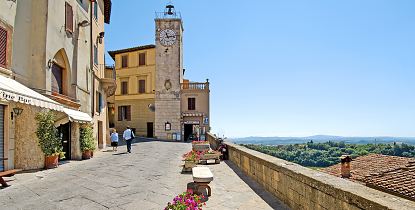| Siena Online (www.sienaonline.com) | |
|
SIENA What to see & do -
Chianciano Terme Of Etruscan origins, Chianciano Terme is a small town immersed in the green Tuscan hills to the south of Siena, between Val d’Orcia and Val di Chiana, not far from the border with Umbria. A number of historians indicate that in antiquity Chianciano was known as Clancianum, meaning “this side of the Chiana”. The first documents in which the name Chianciano appears date from the 12th century, however: an 1171 act of donation and a document from 1230 in which the town is referred to as a Comune.
During the Middle Ages Chianciano Terme was for many years under the governance of the Counts Rimbotti-Manenti (1230-1280), who were eventually deposed and expelled after having successfully reduced the village to poverty. In 1287 Chianciano became a free comune and divided into districts/classes known as Terzieri. The Terziero dei Borghesi was made up of traders and businessmen. Then there were the Terziero dei Militi o Cavalieri and the Terziero dei Pedoni, which was composed of craftsmen, farmers and servants. After a period of relative prosperity, in the 15th and 16th century Chianciano once more fell on difficult times. Rivalry with nearby Montepulciano added to the devastation brought in 1476 by an outbreak of the Plague, which followed an earlier outbreak in 1348. Eventually the town was conquered by Florentine troops and rebuilt under Cosimo I de’ Medici. Following research carried out in the 17th century by the hydrologist Andrea Baccio, Chianciano began to be appreciated for the curative effects of its waters. With the building of the first spa centres, the town’s development became inextricably tied to its thermal baths. Today Chianciano is one of Europe’s best known spa towns. Its mild climate and idyllic position are the perfect setting for the many villas and gardens that have sprung up here, not to mention a number of modern hotels that are equipped to cater for the growing numbers of tourists that come here every year, attracted by the possibility of enjoying an alternative form of holiday that caters for both body and mind. With its three different thermal water springs – Santa, Fucoli and Sillene – Chianciano is unique as a spa town. The Acqua Santa emerges from the soil at a temperature of 33°C and is particularly indicated for disorders of the liver and bile ducts, as well as for chronic gall bladder inflammations and for improving digestion. The Acqua Fucoli emerges at a temperature of 16.5°C and is excellent for rebalancing the intestines, activating diuresis and reducing inflammations of the gastro-duodenal mucosa. The Acqua Sillene, which some believe is named after the Etruscan god Sethlas, others after Silla, emerges at a temperature of 38.5°C and is mainly used for mud therapy around the liver and for immersions. Sant’Elena, at 13°C, is another spring also at Chianciano and indicated for conditions of the kidneys and stomach infections. This water increases diuresis and improves digestion. From Chianciano Terme, Viale della Libertà leads to the old village of Chianciano within the walls. Porta Rivellini opens onto the castle of the Conti Manenti, better known as the Monastero. At the end of the street rises the Torre dell’Orologio, which commands magnificent views over the surrounding countryside, as far as the snow-capped peaks of Monte Cetona and Monte Amiata. After the clock tower there is the main square, Piazza Matteotti, where there is also the Associazione Geo-Archeologica. A number of works have been carried out in recent years in an effort to improve communication between the old village and the new spa town – two quite different entities that nonetheless share a common historical and artistic heritage. Siena Online2005-2024 © by SCG Business Consulting Sas di Giacomelli E. & C. (www.scgconsulting.com) |
